Building-Integrated Photovoltaic Modules Using Additive-Manufactured Optical Pattern
Abstract
:1. Introduction
2. Materials and Methods
2.1. Optical Pattern Simulation
2.2. Additive-Manufactured Optical Pattern
2.3. Module Preparation
2.4. Module Electrical Properties Measurement
3. Results and Discussion
3.1. Optical Simulation
3.2. Optical Pattern Formation
3.3. Output Power According to Incident Angle of Light
4. Conclusions
Author Contributions
Funding
Institutional Review Board Statement
Informed Consent Statement
Data Availability Statement
Conflicts of Interest
References
- Hamilton, I.; Kennard, H.; Rapf, O.; Kockat, J.; Zuhaib, S.; Abergel, T.; Oppermann, M.; Otto, M.; Loran, S.; Steurer, N.; et al. 2020 Global Status Report for Buildings and Construction: Towards a Zero-Emission; United Nations Environment Programme, Efficient and Resilient Buildings and Construction Sector: Nairobi, Kenya, 2020. [Google Scholar]
- Net Zero Tracker. Net Zero Numbers. Available online: http://netzerotracker.net/ (accessed on 23 November 2021).
- Marszal, A.J.; Heiselberg, P.; Bourrelle, J.S.; Musall, E.; Voss, K.; Sartori, I.; Napolitano, A. Zero Energy Building—A review of definition and calculation methodologies. Energy Build. 2011, 43, 917–919. [Google Scholar] [CrossRef]
- World Energy Outlook 2020-Analysis—IEA. Available online: https://www.iea.org/reports/world-energy-outlook-2020 (accessed on 25 December 2021).
- Pelle, M.; Lucchi, E.; Maturi, L.; Astigarraga, A.; Causone, F. Coloured BIPV technologies: Methodological and experimental assessment for architecturally sensitive areas. Energies 2020, 13, 4506. [Google Scholar] [CrossRef]
- Berger, K.; Cueli, A.B.; Boddaert, S.; Buono, M.D.; Delisle, V.; Fedorova, A.; Frontini, F.; Ishii, H.; Kapsis, C.; Kim, J.-T.; et al. International Definition of “BIPV”; IEA: Paris, France, 2018; ISBN 978-3-906042-73-26. [Google Scholar]
- Shukla, A.K.; Sudhakar, K.; Baredar, P. Recent advancement in BIPV product technologies: A review. Energy Build. 2017, 140, 188–195. [Google Scholar] [CrossRef]
- Bao, Q.; Honda, T.; Ferik, S.; Shaukat, M.M.; Yang, M.C. Understanding the role of visual appeal in consumer preference for residential solar panels. Renew. Energy 2017, 113, 1569–1579. [Google Scholar] [CrossRef] [Green Version]
- Zhang, T.; Wnag, M.; Yang, H. A Review of the Energy Performance and Life-Cycle Assessment of Building-Integrated Photovoltaic. Energies 2018, 11, 3157. [Google Scholar] [CrossRef] [Green Version]
- Durante, A.; Lucchi, E.; Maturi, L. Building integrated Photovoltaic in heritage contexts award: An overview of best practices in Italy and Switzerland. IOP Conf. Ser. Earth Environ. Sci. 2021, 863, 012018. [Google Scholar] [CrossRef]
- Liu, B.; Duan, S.; Cai, T. Photovoltaic DC-Building-Module-Based BIPV System-Concept and Design Condideration. IEEE Trans. Power Electron. 2011, 26, 1418–1429. [Google Scholar] [CrossRef]
- Biyik, E.; Araz, M.; Hepbasli, A.; Shahrestani, M.; Yao, R.; Shao, L.; Essah, E.; Oliveira, A.C.; Caño, T.; Rico, E.; et al. A key review of building integrated photovoltaic (BIPV) systems. Eng. Sci. Technol. Int. J. 2017, 20, 833–858. [Google Scholar] [CrossRef]
- Ravyts, S.; Vecchia, M.D.; Broeck, G.V.; Driesen, J. Review on Building-Integrated Photovoltaics Electrical System Requirements and Mod-ule-Integrated Converter Recommendations. Energies 2019, 12, 1532. [Google Scholar] [CrossRef] [Green Version]
- Lee, H.; Song, H.-J. Current status and perspective of colored photovoltaic modules. WIREs Energy Environ. 2021, 10, 403. [Google Scholar] [CrossRef]
- Hille, S.L.; Curtius, H.C.; Wüstenhagen, R. Red is the new blue—The role of color, building integration and country-of-origin in homeowners’ preferences for residential photovoltaics. Energy Build. 2018, 162, 21–31. [Google Scholar] [CrossRef]
- Ghosh, A. Potential of building integrated and attached/applied photovoltaic(BIPV/BAPV) for adaptive less energy-hungry building’s skin: A comprehensive review. J. Clean. Prod. 2020, 276, 123343. [Google Scholar] [CrossRef]
- Eder, G.; Peharz, G.; Trattnig, R.; Bonomo, P.; Saretta, E.; Frontini, F.; Lopez, C.S.; Wilson, H.R.; Eisenlohr, J.; Chivelet, N.M.; et al. COLOURED BIPV-Market, Research and Development; IEA: Paris, France, 2019. [Google Scholar]
- Jolissaint, N.; Hanbali, R.; Hadorn, J.-C.; Schüler, A. Colored solar facades for building. Energy Procedia 2017, 122, 175–180. [Google Scholar] [CrossRef]
- Eder, G.C.; Knöbl, K.; Maul, L.; Aichinger, M.; Peharz, G.; Nemitz, W.; Berge, K.A. Designed BIPV-Elements with Printed Front-Glass: Simulation and Experimental Evaluation of the Effect of Printing on the Electrical Performance. In Proceedings of the 33th PV-SEC, Amsterdam, The Netherlands, 25–29 September 2017; pp. 1295–1303. [Google Scholar]
- Kameleon Solar. Available online: Kameleonsolar.com/products/colorblast/ (accessed on 23 November 2021).
- Reese, M.O.; Glynn, S.; Kempe, M.D.; McGott, D.L.; Dabney, M.S.; Barnes, T.M.; Booth, S.; Feldman, D.; Haegel, N.M. Increasing markets and decreasing package weight for high-specific-power photovoltaics. Nat. Energy 2018, 3, 1002–1012. [Google Scholar] [CrossRef]
- PVLighthouse. Refractive Index Library. Available online: www.pvlighthouse.com/au/ko/refractive-index-library/ (accessed on 30 November 2021).
- Solar Geometry Calculator. Available online: gml.noaa.gov/grad/antuv/SolarCalc.jsp?mu=on&sza=on&el=on&az=on/ (accessed on 30 November 2021).
- Reddy, C.R. Performance of Ceramic Ink Printed Colour Photovoltaic Technology. Master’s Thesis, Delft University of Technology, Delft, The Netherlands, 2018. [Google Scholar]
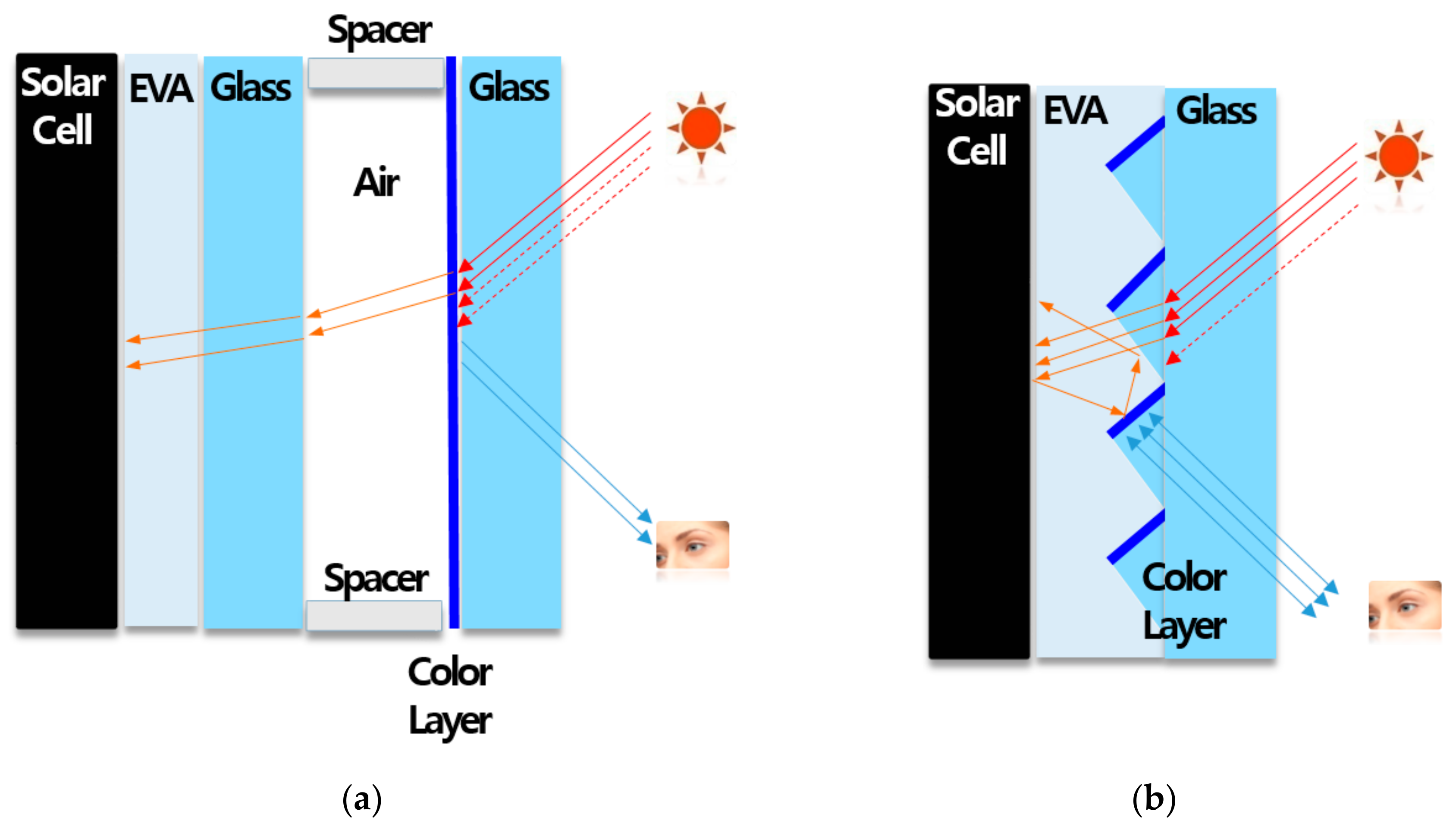
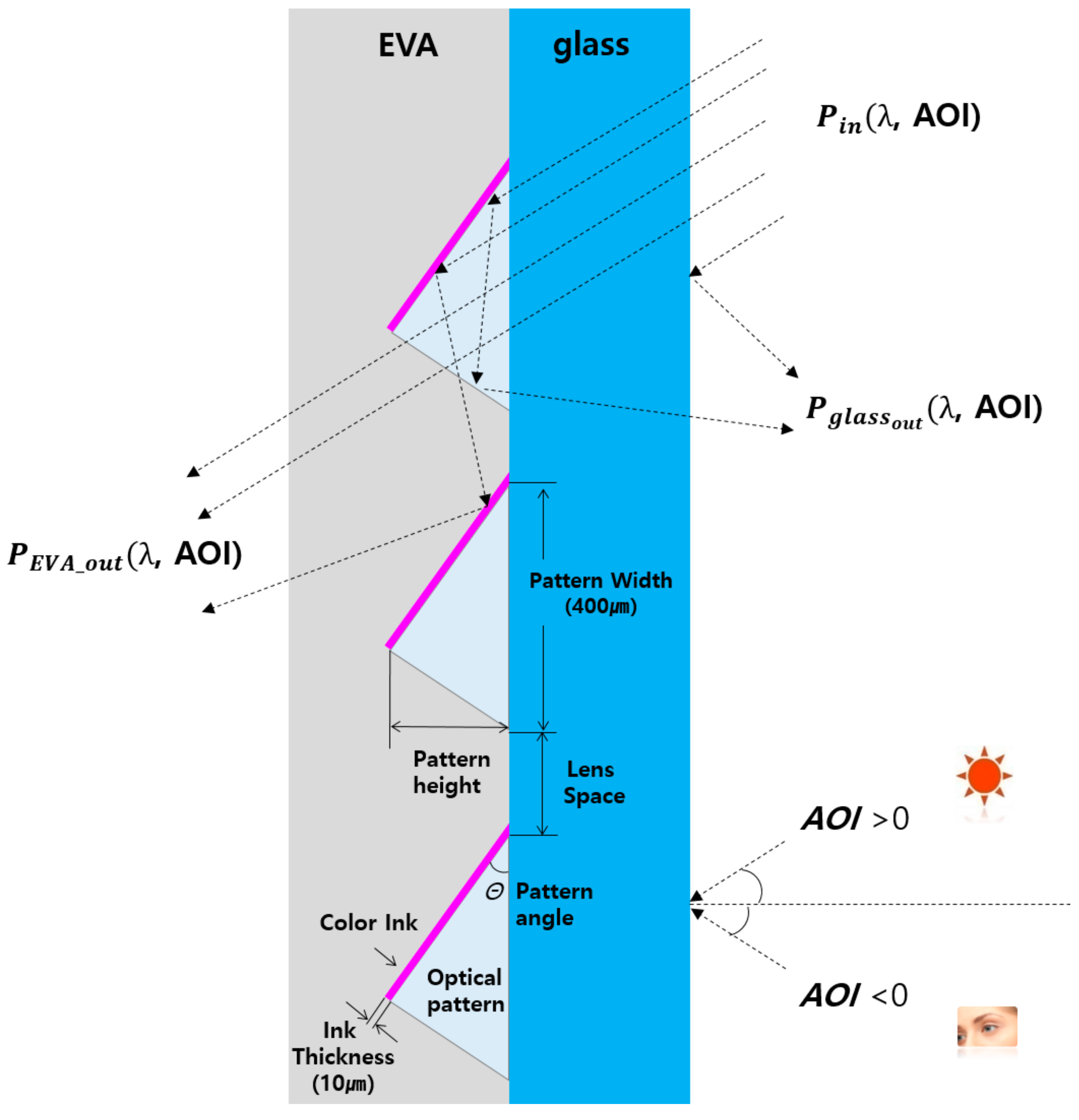



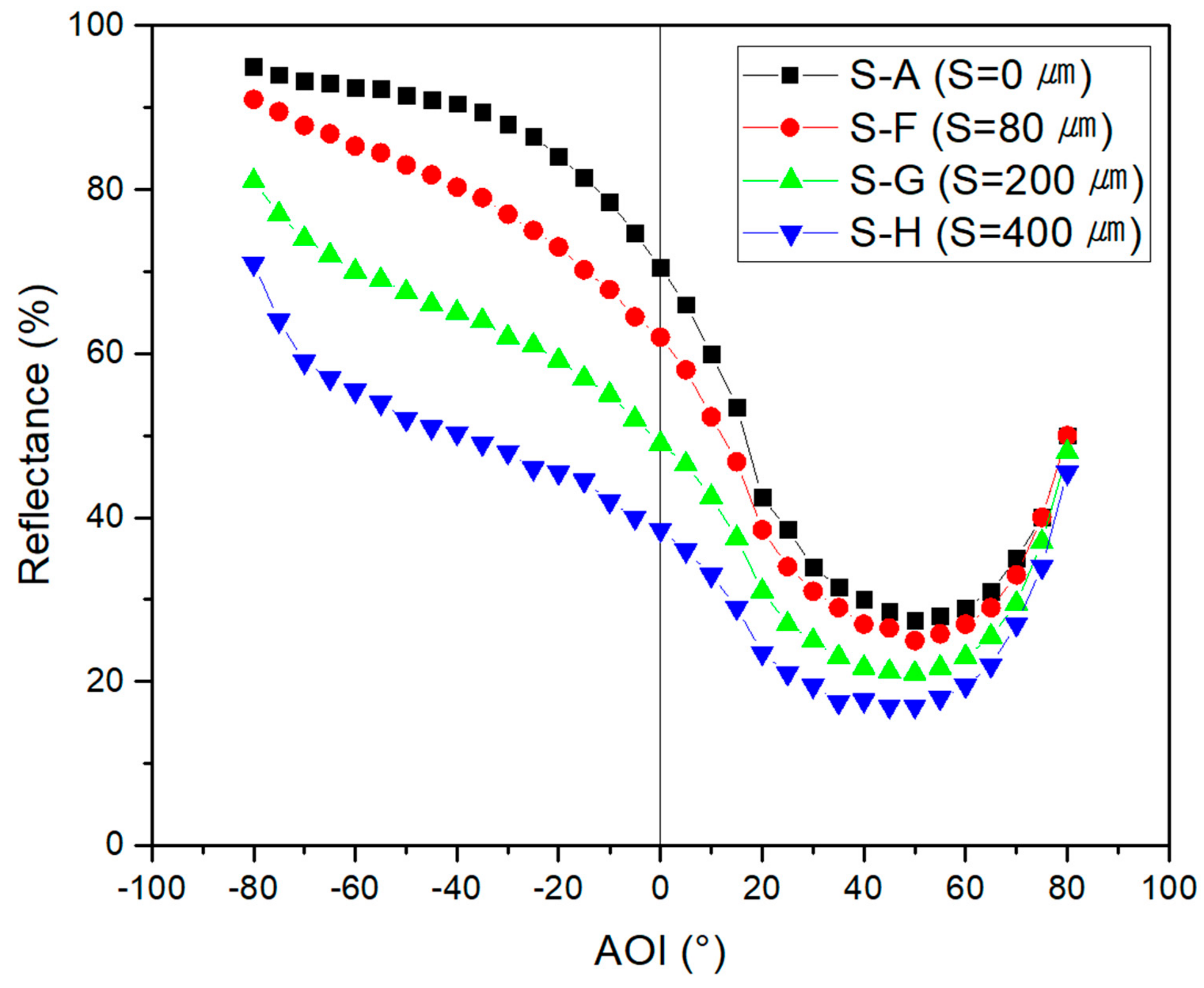
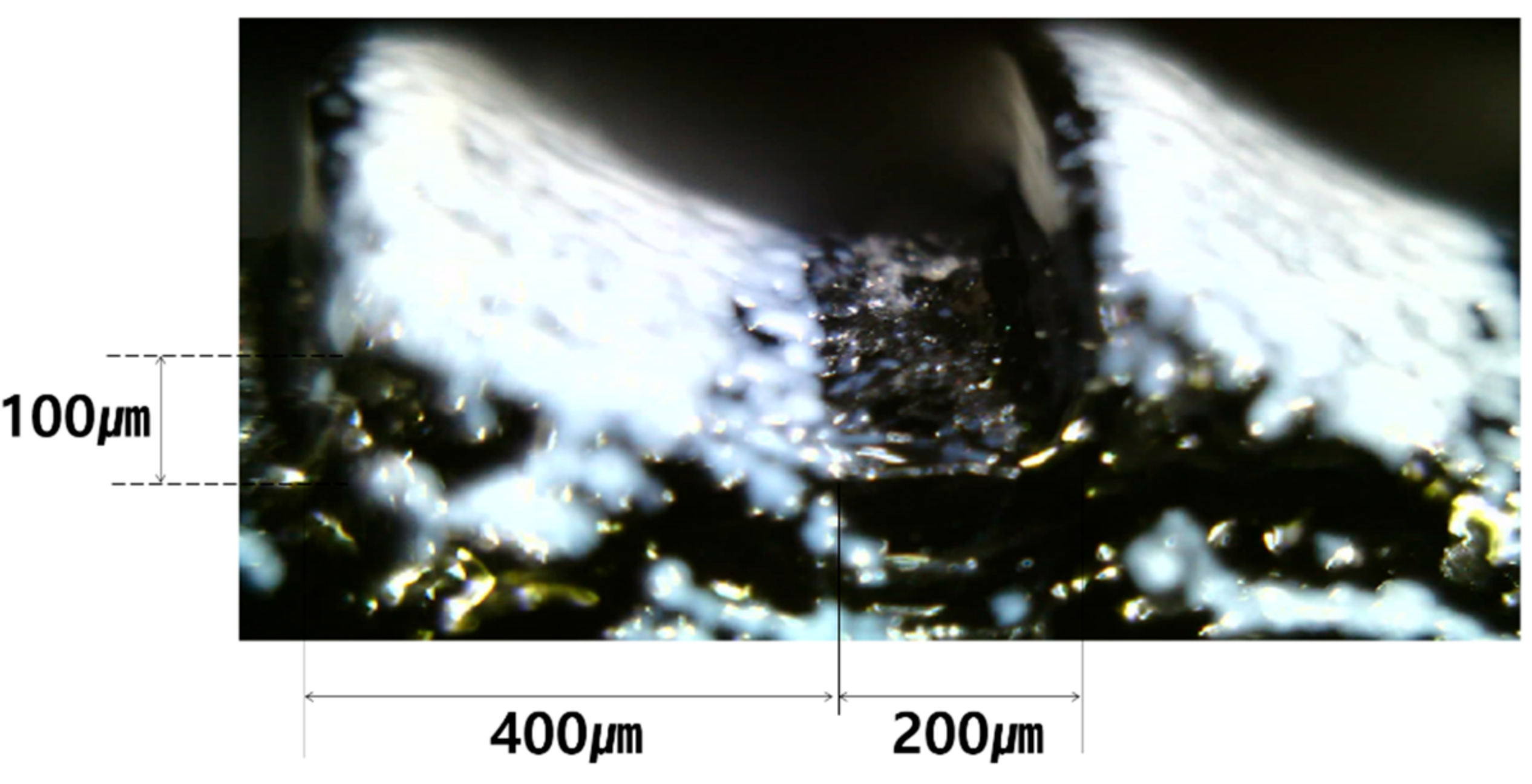

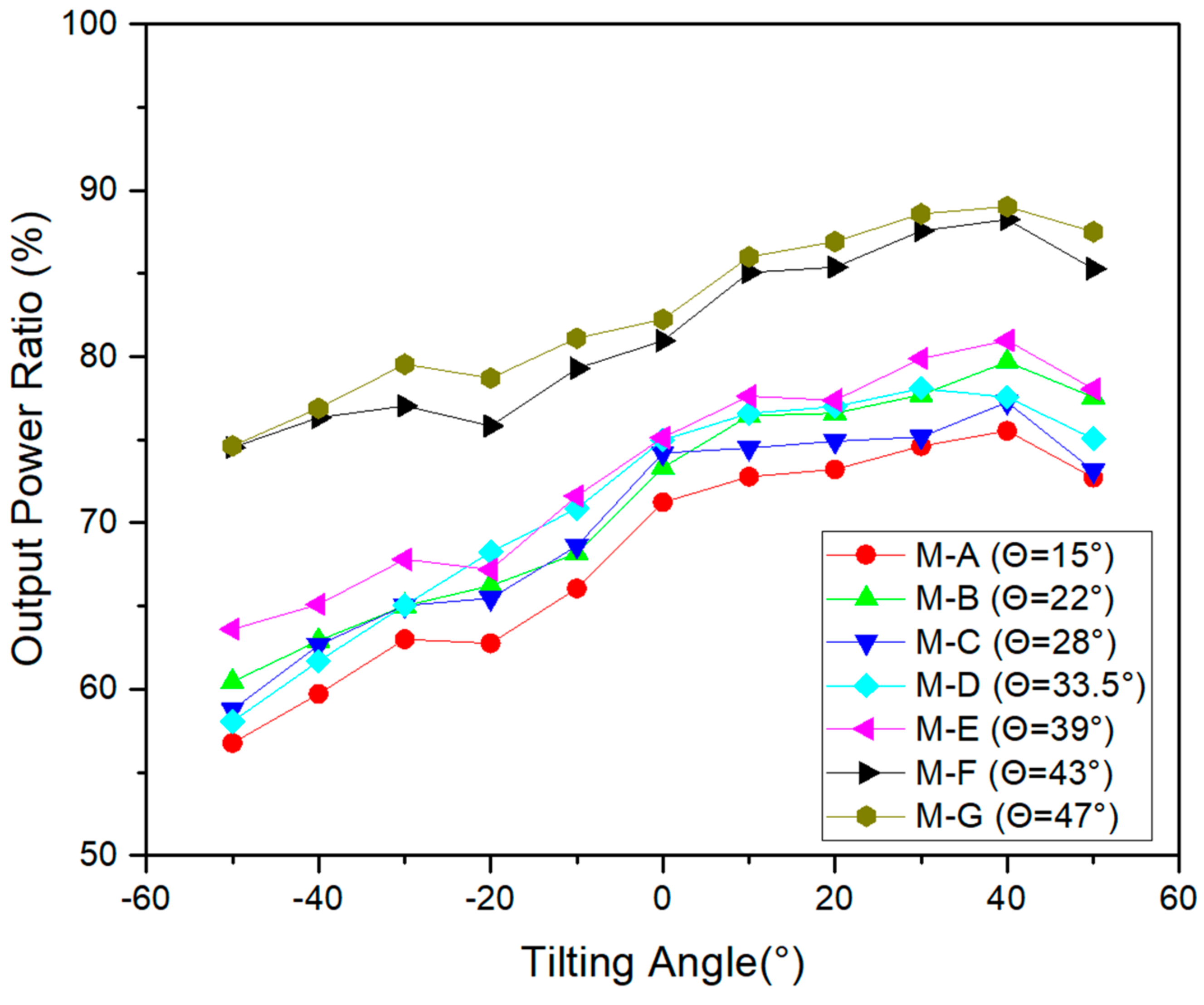
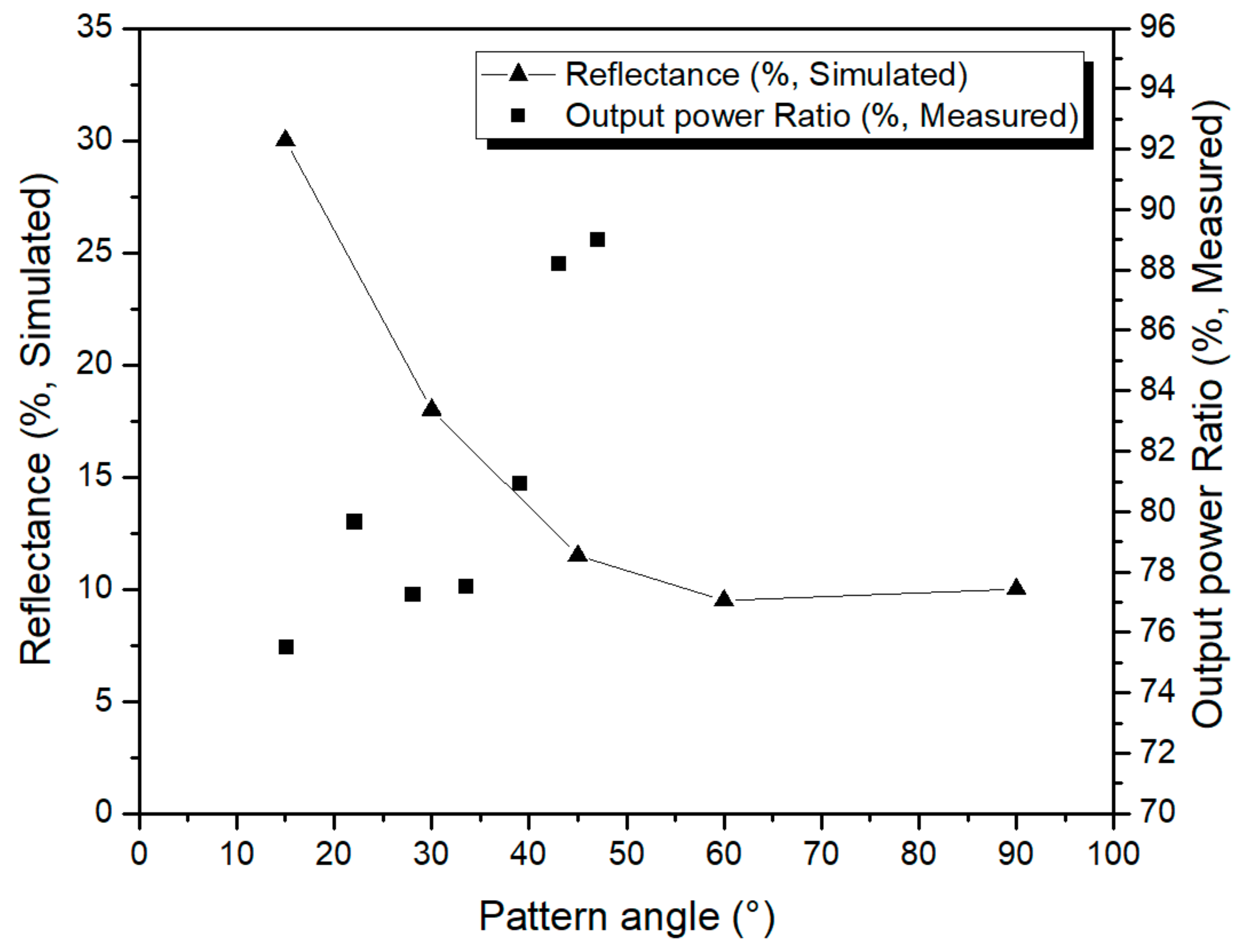
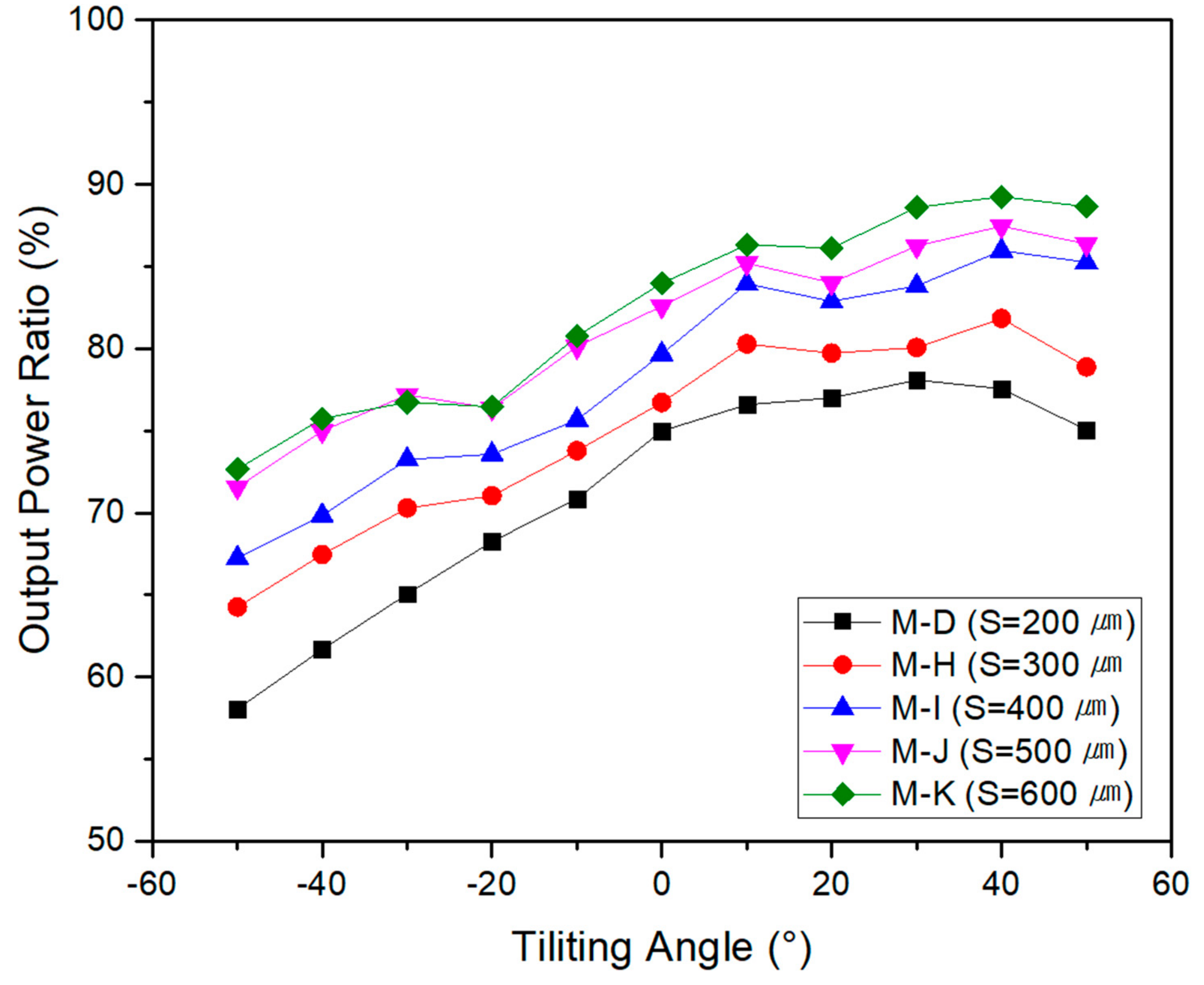

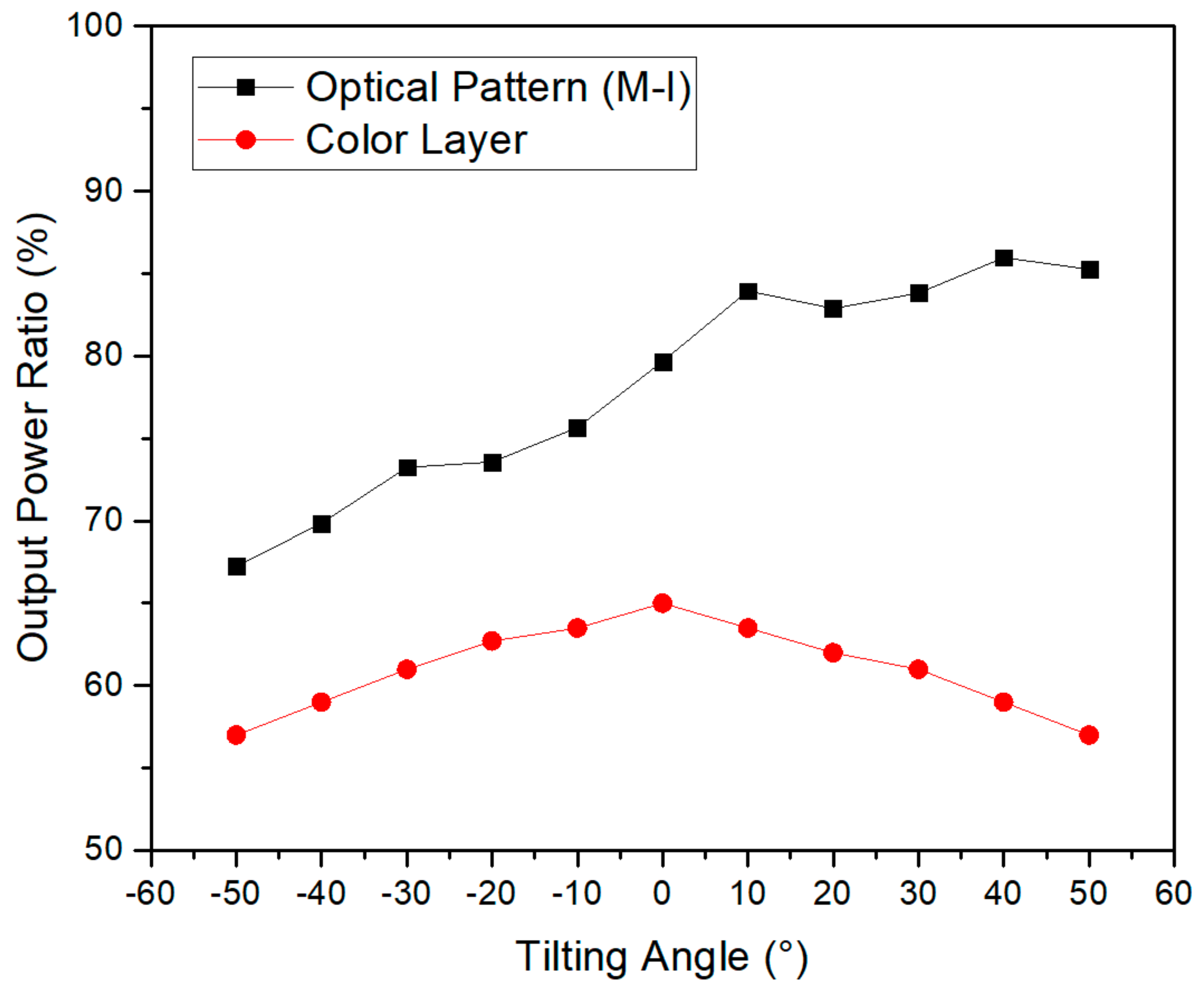
| Simulation Model | Pattern Angle, θ (°) | Lens Space, S (μm) |
|---|---|---|
| S-A | 15 | 0 |
| S-B | 30 | 0 |
| S-C | 45 | 0 |
| S-D | 60 | 0 |
| S-E | 90 | 0 |
| S-F | 15 | 80 |
| S-G | 15 | 200 |
| S-H | 15 | 400 |
| Layer | 450 nm | 550 nm | 650 nm | |
|---|---|---|---|---|
| Refractive index | Glass | 1.502 | 1.495 | 1.491 |
| UV resin | 1.509 | 1.504 | 1.499 | |
| EVA | 1.500 | 1.495 | 1.489 | |
| Absorption Coefficient (/cm) | Glass | 2.425 × 10−3 | 1.284 × 10−3 | 1.735 × 10−3 |
| UV resin | 4.854 × 10−3 | 3.771 × 10−3 | 4.219 × 10−3 | |
| EVA | 9.682 × 10−3 | 5.372 × 10−3 | 3.708 × 10−3 |
| Module Name | Lens Space, S (μm) | Pattern Height (μm) | Pattern Angle, θ (°) |
|---|---|---|---|
| M-A | 200 | 100 | 15 |
| M-B | 200 | 150 | 22 |
| M-C | 200 | 200 | 28 |
| M-D | 200 | 250 | 33.5 |
| M-E | 200 | 300 | 39 |
| M-F | 200 | 350 | 43 |
| M-G | 200 | 400 | 47 |
| M-H | 300 | 250 | 33.5 |
| M-I | 400 | 250 | 33.5 |
| M-J | 500 | 250 | 33.5 |
| M-K | 600 | 250 | 33.5 |
| Simulation Model | Asymmetric Factor (As) |
|---|---|
| S-A | 0.87 |
| S-B | 1.54 |
| S-C | 0.83 |
| S-D | 0.58 |
| S-E | 0.0 |
| S-F | 0.86 |
| S-G | 0.88 |
| S-H | 0.85 |
| Fabricated Module | Asymmetric Factor (As) |
|---|---|
| M-A | 0.222 |
| M-B | 0.229 |
| M-C | 0.197 |
| M-D | 0.212 |
| M-E | 0.211 |
| M-F | 0.147 |
| M-G | 0.147 |
| M-H | 0.187 |
| M-I | 0.202 |
| M-J | 0.151 |
| M-K | 0.161 |
Publisher’s Note: MDPI stays neutral with regard to jurisdictional claims in published maps and institutional affiliations. |
© 2022 by the authors. Licensee MDPI, Basel, Switzerland. This article is an open access article distributed under the terms and conditions of the Creative Commons Attribution (CC BY) license (https://creativecommons.org/licenses/by/4.0/).
Share and Cite
Kim, Y.-S.; Kim, A.-R.; Tark, S.-J. Building-Integrated Photovoltaic Modules Using Additive-Manufactured Optical Pattern. Energies 2022, 15, 1288. https://doi.org/10.3390/en15041288
Kim Y-S, Kim A-R, Tark S-J. Building-Integrated Photovoltaic Modules Using Additive-Manufactured Optical Pattern. Energies. 2022; 15(4):1288. https://doi.org/10.3390/en15041288
Chicago/Turabian StyleKim, Young-Su, A-Rong Kim, and Sung-Ju Tark. 2022. "Building-Integrated Photovoltaic Modules Using Additive-Manufactured Optical Pattern" Energies 15, no. 4: 1288. https://doi.org/10.3390/en15041288





